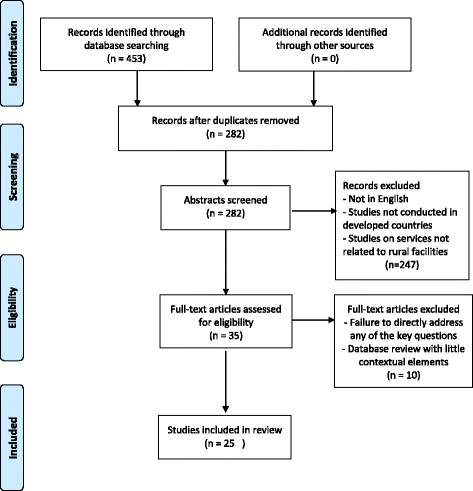The enablers, barriers and preferences of accessing radiation therapy facilities in the rural developed world - a systematic review
- PMID: 29179701
- PMCID: PMC5704551
- DOI: 10.1186/s12885-017-3790-7
The enablers, barriers and preferences of accessing radiation therapy facilities in the rural developed world - a systematic review
Abstract
Background: Utilisation of radiation therapy for regional Australia and around the world has been the focus of much health policy the last decade. Radiation therapy centres have been built in Australian regional and rural areas to improve access to radiation therapy and reduce the tyranny of distance as a barrier to access. After this the enablers, barriers and perceptions of patients has been evaluated to determine utilisation once centres have been built. Thisreview looks the impact of rural radiation services in the developed world, barriers and enablers of establishing a rural radiation centre, and patients' and service providers' perspectives and preferences around the uptake of rural radiation therapy.
Methods: Online search of peer reviewed literature was undertaken using MeSH terms relating to the topic. Inclusion criteria were regional radiation therapy centres in developing countries, any year of publication, in English, and qualitative or quantitative methodologies. Articles were reviewed by two authors with conflicts discussed with a third.
Results: Twenty three studies addressed the theme directly. Distance barriers have been overcome by building regional centres and health economic burden was lower for government service providers with this strategy. However distance still plays an important role in influencing uptake of radiation therapy. Cultural expectations, influence of the family doctor and perception of care was influential. Carer support, duration of displacement from home, financial impact of the required care and seasonal weather were practical factors on a patient's decision.
Conclusions: Regional radiation therapy centres have improved access to radiation therapy in developing countries. However the complex nuances between socio-economic, cultural and health system factors that influence regional patient's decision making bears further consideration, as distance is not the only issue.
Keywords: Access; Barriers; Decision making; Enablers; Radiation therapy; Regional; Rural; Utilisation.
Conflict of interest statement
Authors’ information
Not applicable.
Ethics approval and consent to participate
Not applicable.
Consent for publication
Not applicable.
Competing interests
The authors declare that they have no competing interests.
Publisher’s Note
Springer Nature remains neutral with regard to jurisdictional claims in published maps and institutional affiliations.
References
-
- Radiologists RAaNZCo Faculty of Radiation Oncology Facilities Survey. Insidenews. 2015;11(4):16.
-
- Celaya MO, Rees JR, Gibson JJ, Riddle BL, Greenberg ER. Travel distance and season of diagnosis affect treatment choices for women with early-stage breast cancer in a predominantly rural population (United States) Cancer Causes Control. 2006;17(6):851–856. doi: 10.1007/s10552-006-0025-7. - DOI - PubMed
-
- Royal Australian and New Zealand College of Radiology, RANZCR. Tripartite National Strategic Plan for radiation oncology 2012–2022. Sydney: Royal Australian and New Zealand College of Radiology; 2012.
Publication types
MeSH terms
LinkOut - more resources
Full Text Sources
Other Literature Sources
Medical


